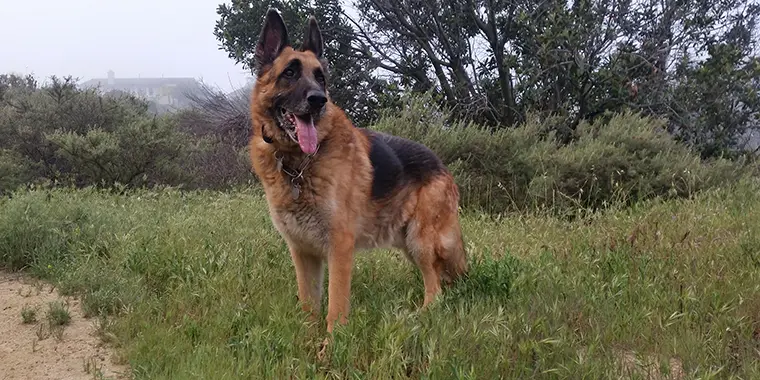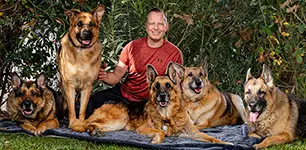
I published What is the Best Food for a German Shepherd in December 2009. Subsequently, in February 2011, I significantly revised it and then refined the article further with additional thoughts and experiences in February 2021. I own and feed six German Shepherds. Feeding the best food for German Shepherds is a long-time passion.
I LOVE MY DOGS! Most pet owners feel the same way. I want my dogs to live long, healthy, and happy lives. Hence, besides enough physical activity and mental stimulation, I ensure they eat the best food I can provide. I lost two dogs to cancer in the past. Both were about fourteen years of age at the time. As a result, I became very focused on preventing that going forward. Did you know that cancer is the number one cause of death in dogs? Despite what anyone tells you, that’s hardly normal or acceptable. Certainly, the reasons for this are debatable. However, looking at the ingredients in dog food, I am pretty sure I know where most of the blame lies. It’s crappy dog food.
The Challenges
Certainly, no one means to feed crappy food. But how do you know which dog food is better? Dog food companies don’t make it easy for us because they don’t have to. Most dog food in bags contains by-products, meats with growth hormones, and antibiotics. Also, common fillers, like brewer’s yeast, tapioca starch, and pea protein. As a result, 50% of most dog foods consist of carbohydrates. Those become sugar upon digestion. Certainly, none of that is good nutrition.
In short, most dog food is pretty bad for dogs. In the same way as living on a fast-food diet of burgers and fries. And don’t even get me started on vegan dog food. Undoubtedly, dogs are omnivores but more on the carnivore side. Further, if you think the dog food your vet wants to sell you is better, I have more bad news. That is not the best food for a German Shepherd either.
Much food in grocery aisles—manufactured by mega food companies—is not healthy for people. Don’t take my word for it; read the labels. While you’re at it, look at human cancer rates too. If you want to dive in, I recommend the textbook Cancer as a Metabolic Disease: On the Origin, Management, and Prevention of Cancer by Thomas Seyfried. He was an Associate Professor in the Department of Biology at Boston College.
The Best Food for a German Shepherd is Breed-Specific
Similarly, the same challenges we experience with our food apply to dog food. I want to ensure I feed my dogs the best food for German Shepherds. But like everyone, I also have to watch the price tag. So, I advise feeding the best food you can afford and doing better when you can. Feeding a dog food appropriate and healthy for each breed matters. What good are organic blueberries in your dog’s food if blueberries have no nutritional benefit to your dog? Thus, the most important thing to understand is that when it comes to the right dog food: BREED MATTERS!
This article addresses the basics of German Shepherd nutrition and gives you additional resources to learn about the nutritional needs of other breeds. All information is based on years of research, feeding my dogs, and the advice of the late canine nutritionist and animal advocate William D. Cusick. Mr. Cusick published breed-specific nutritional guides, including recipes. Consequently, these form the basis for feeding the best food for a German Shepherd. His books are very informative. A free copy of his previous best-selling dog nutrition guide can be found here: Canine Nutrition.
This information is for educational purposes only, and you should always consult with a canine nutritionist (not a vet) before making any significant nutritional adjustments or have any concerns or questions. Furthermore, if you want to take a deep dive, or get a raw recipe formulated from scratch for any breed, check out Raw, Fed and Nerdy.
So let’s get to what I feed my German Shepherd Dogs and why.
From “Canine Nutrition & Choosing The Best Food For Your Breed Of Dog” by William D. Cusick
“The German Shepherd originated in the Alsatian Region of Germany. The official name for this breed is German Shepherd Dog, although it is usually called German Shepherd or just Shepherd. The German Shepherd is unique because it has a very short colon compared to other breeds of the same body weight. For this reason, a high-fiber diet is required to slow food movement through this breed’s digestive tract, allowing more time for the nutrients to be drawn out. This high-fiber diet will result in a larger stool but better assimilation of the food.
The environment for the Alsatian Region of Germany provided this breed with primary food sources of beef, wheat, and leafy greens like cabbage and alfalfa. Thus, I recommend a blend of these food sources as the ideal base diet for the German Shepherd. Conversely, I feel the worst commercial food blend for the German Shepherd Dog would contain fish, soy, or rice.”
Why Does It Matter?
As a consequence, my dogs’ diet is based on beef, wheat, and cabbage, and I avoid fish, soy, or rice. But let’s be realistic, knowing what my dogs should eat and mixing that all up in a way they will eat it are two very different things. In their original habitat, they would consume these types of things naturally. However, they would not walk up to some spinach plant and start chewing. They are dogs, and dogs eat and NEED meat; dogs are omnivores. In nature, they hunt down any smaller animal, kill it and eat it. Dogs get a lot of nutrition by eating the stomach, and the half-digested content of their dinner kill—don’t think about that for too long, but that is how dogs in the wild get their vegetables.
Obviously, that won’t fly around here. So, I decided to purchase William D. Cusick’s “The Best Diet for a German Shepherd Dog” manuscript, and I cooked my German Shepherds food following his recipe for seven years before transitioning to raw food—more on that below. My German Shepherds love their food and thrive on it. As a result, they have higher energy levels, have gained muscle mass, and are 100% healthy. Further, my dogs don’t need flea or tick medications either—the garlic in the food is a natural pest repellent. My German Shepherds are very healthy dogs! Clearly, feeding the best food for a German Shepherd makes a difference. Food matters!
The Effort of Making Your Dog’s Food from Scratch
We will look at raw food below, but I used to cook weekly. It took about 2 hours (including clean-up) to prepare 14 portions and box them. We have a small refrigerator in the garage dedicated to their food. I had my dogs on a twice-a-day feeding schedule. It is well worth it, in my view, and it only cost about $40 a week to have healthy, nutritious, good tasting—from a dog’s perspective—dog food.
The following table is for reference purposes only. You should NOT start mixing up dog food without a proper recipe. The right amount of each ingredient is essential for it to be healthy. For example, a small amount of garlic in my German Shepherd’s food will keep ticks and fleas away, while a too high amount is toxic. So please, get the recipe referenced above if you are serious about feeding the best food for a German Shepherd.
The Nutrition
| German Shepherd Dog Nutritional Needs |
Best Food Sources |
|---|---|
|
Vitamin A Palmitate Source: WH Foods |
cabbage, carrot, broccoli, squash |
|
Vitamin B-1 Source: WH Foods |
cabbage, carrot, yellow corn, squash, broccoli |
|
Vitamin B-2 Source: WH Foods |
broccoli, cabbage, squash, beef |
|
Vitamin B-6 Source: WH Foods |
chicken, beef, garlic, cabbage, broccoli, carrot, squash, potato |
|
Vitamin B-12 Source: WH Foods |
beef |
|
Vitamin D Source: WH Foods |
cheese |
|
Vitamin E Source: WH Foods |
broccoli |
|
Niacinamide (B3) Source: WH Foods |
broccoli, chicken, squash, carrot, beef |
|
Biotin Source: WH Foods |
carrot (raw) |
|
Folic Acid Source: WH Foods |
broccoli |
|
d-Calcium Pantothenate (B5) Source: WH Foods |
yellow corn, broccoli, squash |
|
Para Amino Benzoic Acid (PABA) Source: RX List |
whole-grain wheat |
|
Calcium Source: WH Foods |
cheese, broccoli, cabbage, squash, garlic |
|
Copper Source: WH Foods |
squash, cheese, potato, garlic |
|
Iodine Source: WH Foods |
cheese |
|
Iron Source: WH Foods |
cheese, broccoli, squash, beef |
|
Magnesium Source: WH Foods |
cheese, squash, broccoli, whole grain wheat, cabbage |
|
Manganese Source: WH Foods |
garlic, squash, whole grain wheat, broccoli, cabbage, carrots, yellow corn |
|
Phosphorus Source: WH Foods |
cheese |
|
Potassium Source: WH Foods |
broccoli, squash, carrots, cabbage, potato |
|
Zinc Source: WH Foods |
beef, squash, broccoli |
The information above ensures my German Shepherds get what they need to be healthy. However, I have been adding a couple of other things to my dogs’ food for years with excellent results. Some additions to consider can be found on ourDog Health page. These are specific nutritional supplements not found in food. I consider these essential for the best food for a German Shepherd.
The Next Phase
I have been doing this for quite a while, and my dogs are thriving on this diet. I strongly recommend you look at the individual breed nutrition guides from William Cusick, as they have been a great starting point for me.
Subsequently, I started transitioning my dogs to raw food in August 2016. I had seen the benefits in another German Shepherd who joined my family for several years until he, unfortunately, had to be euthanized. I rescued him with a spinal injury, and he never fully recovered despite surgery. He had a good but too short life. Neko was only eleven years old at the time. I rescued him when he was seven years old.
Neko was the first dog I transitioned to a raw diet. I started with a commercial raw food appropriate for German Shepherds, but it wasn’t breed-specific. What I saw in Neko convinced me that this was a superior way of feeding. However, I did have the perfect nutritional balance in my cooked food and did not want to give that up. As a result, I recreated the best food for a German Shepherd as a raw food version.
Creating the Recipe
Over the next four weeks, I painstakingly analyzed the nutritional profile of my breed-specific, cooked German Shepherd recipe and rebuilt the same nutritional profile as a raw recipe. You should see my spreadsheets! I used the book Unlocking the Ancestral Diet to bring The Best Diet for a German Sheperd into a raw food format. Mr. Cusick had objections to raw feeding. But his objections were more related to the quality and safety of the meat supply. This is a fair concern, but there are solutions to this problem.
Neko was the first beneficiary of this new recipe as he was already on a raw diet. That transition went without a hitch. Over the following two weeks, Sylvester and all my other German Shepherds transitioned to the new raw food recipe. My dogs are thriving on this food. This is truly the best food for German Shepherds.
Raw Food Safety
One concern people have with raw feeding is contaminants like e-Coli, salmonella, or Campylobacter, to name a few. Dogs can indeed get sick from those bacteria. But, this is only a risk if the dog does not eat raw food consistently. Naturally, dogs are scavengers. They eat buried, rotten meat, roadkill, and other ‘delicacies’ of this nature. In wild dogs, the stomach acidity (PH) is around 2.0. That is highly acidic. A dog with a stomach PH of 2.0 can eat meat infested with the above bacteria without any issues. Its stomach acid will kill all of that and then some. However, dogs on commercial kibbles or cooked diets don’t have that protection.
Luckily, after two weeks of raw feeding, your dog’s stomach acid will return to its natural 2.0 PH state, and your dog will be fully protected should a bad bacteria find its way into their food. I never had any issues in my six years feeding dogs raw diets. If you are interested, the veterinary article Gastric Acidity, Digesting Bones, Gut Transit Time, and Salmonella goes into more detail.
Back to the meat supply. To ensure high meat quality, find a trustworthy meat farm. Harmony Farms is relatively local to me, and they supply me with all the meat I need for my dogs. They fill my meat freezer twice a month. I never had any issues with their meats, and I avoid growth hormones and antibiotics. This is very important when creating the best food for a German Shepherd.
In 2020 I started offering my raw version of the Best Food for a German Shepherd recipe for sale.
Play the Audio





